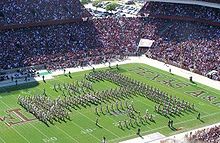Military style bands

Texas A&M's "aTm" formation during halftime
Active duty military marching bands often perform in parades with other military units and march in the same manner as other military personnel. Due to a lack of appreciation, competition venues, and military personnel, almost all military marching bands have disappeared from schools in the United States; notable exceptions the Fightin' Texas Aggie Band from Texas A&M University, the Highty-Tighties of the Virginia Tech Corps of Cadets, and the Cadets of Norwich University Military College of Vermont, the oldest collegiate band in the United States and the nation's first private military academy. There is also a pocket of about 80 high school military-style marching bands in Eastern Texas which enjoy a strong cult following.
Unlike in the United States, military style marching bands have a strong presence in Latin American countries, especially those that have strong military traditions, most importantly of Prussian, French, Spanish and Portuguese origins. Such bands (military bands and Corps of Drums) are found in Chile, Argentina, Bolivia, Brazil, Uruguay, Colombia and Peru. But in Ecuador and Venezuela, Corps of Drums are the main military style band for schools. Military style Corps of Drums are also seen in schools, colleges and universities in Mexico and in Mexican schools in the US merely using only the snare drum and the bugle (in some schools the instrumentation can be larger). These bands also are present in Guatemala, Belize, Nicaragua, El Salvador and Panama.
The United Kingdom keeps the military style tradition with many civil and youth bands in all of the UK keeping the military band traditions of the country, either as marching wind bands, Corps of Drums, bugle bands, pipe bands, and in Northern Ireland, fife and drum bands. Examples would be the Royal British Legion bands, and the bands of the various UK youth uniformed organizations. Styled on the UK military tradition, Fiji's Military Forces also have a marching band.[4] Military style marching bands are also commonplace in Germany, Austria, the Russian Federation, Ukraine, Belarus, Italy, Spain, Portugal and France. German and French military style band types can even extend to Corps of Drums and fanfare bands staffed full-time by civilian musicians, and even to the Bagad bands in Brittany and outside France made up of bagpipers. Spanish band traditions include military style brass bands, marching bands (using brass, woodwinds and percussion) and bugle bands and the Asturias region's unique pipe bands.
Tidak ada komentar:
Posting Komentar